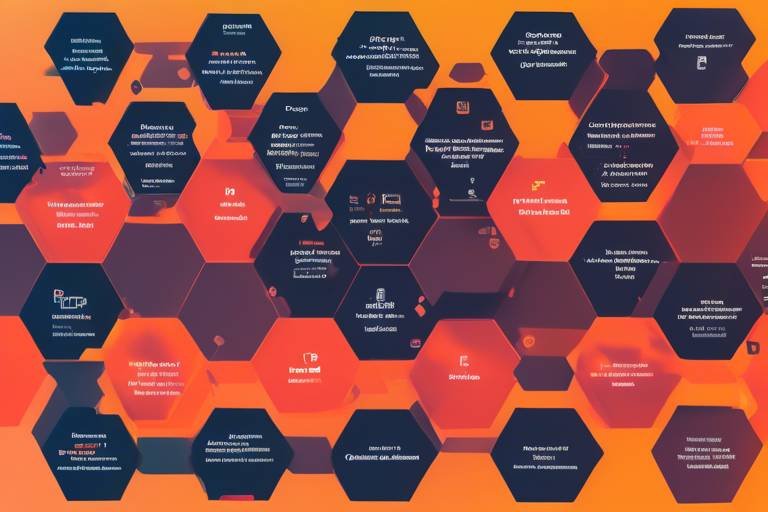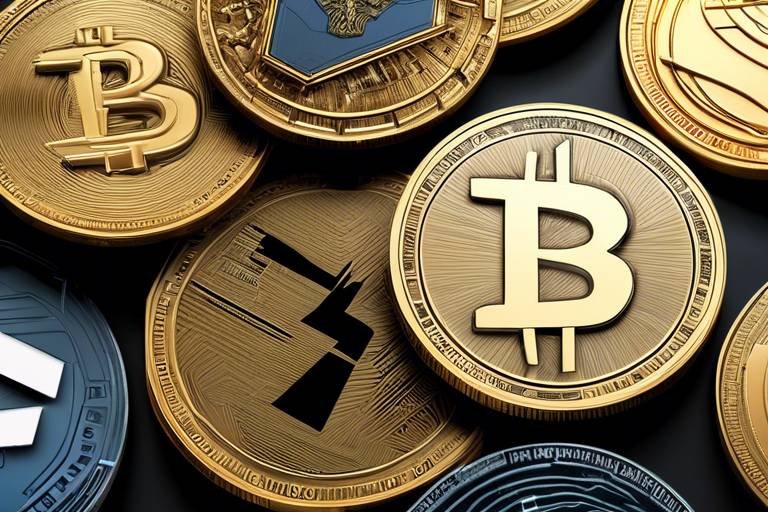The Graph - Blockchain Data Indexing Explained
In the ever-evolving world of blockchain technology, data indexing has emerged as a vital component for the smooth operation of decentralized applications (dApps). But what exactly is blockchain data indexing, and why is it so significant? Imagine trying to find a specific book in a massive library without a catalog. Frustrating, right? This is precisely the challenge faced by developers and users in the blockchain ecosystem without an effective indexing solution. Enter The Graph, a revolutionary protocol designed to streamline data access and enhance the performance of dApps. This article will explore the ins and outs of blockchain data indexing through The Graph, shedding light on its functionality, architecture, and future prospects.
Blockchain data indexing is the process of organizing and categorizing data stored on a blockchain to facilitate efficient retrieval. As blockchains grow larger, the amount of data they contain increases exponentially, making it challenging to access specific pieces of information quickly. This is where indexing comes into play. By creating a structured format for data, indexing allows developers to retrieve information faster, thereby improving the overall performance of decentralized applications. Without proper indexing, users would face delays and inefficiencies, which could deter them from using these innovative platforms.
The Graph plays a pivotal role in the blockchain ecosystem as a decentralized protocol for indexing and querying blockchain data. Think of it as a Google for blockchain, where developers can easily access the information they need to build and maintain their applications. By using The Graph, developers can focus on creating innovative solutions without getting bogged down by the complexities of data retrieval. This streamlined access not only benefits developers but also enhances the user experience by providing faster and more reliable data.
At its core, The Graph utilizes a unique architecture that consists of several components working together to index data efficiently. When data is added to a blockchain, The Graph creates an index of that data, allowing for quick and easy access. The process involves several steps:
- Data Ingestion: Data is pulled from various blockchains.
- Indexing: The data is organized into a format that can be easily queried.
- Querying: Developers can use GraphQL to retrieve specific data points as needed.
This architecture ensures that data is not only accessible but also organized in a way that enhances efficiency and usability.
Within The Graph ecosystem, subgraphs are essential entities that define how data is indexed and queried. A subgraph is essentially a specific set of data from a blockchain that is organized for easy access. Developers can create subgraphs tailored to their applications, allowing them to focus on the data that matters most. The creation of subgraphs is a straightforward process that involves defining the data source, specifying the data structure, and deploying it on The Graph network. This flexibility enables developers to curate their data, ensuring that they can retrieve exactly what they need without unnecessary clutter.
GraphQL is the powerful query language that The Graph employs to facilitate data retrieval. Unlike traditional REST APIs, which require multiple requests to fetch related data, GraphQL allows developers to obtain all the necessary information in a single query. This efficiency not only saves time but also reduces the load on the network. With GraphQL, developers can specify exactly what data they want, making it a highly effective tool for accessing indexed sources.
Utilizing The Graph offers numerous advantages that can significantly impact the development and functionality of decentralized applications. Some of the key benefits include:
- Improved Data Accessibility: Quick and easy access to indexed data enhances user experiences.
- Reduced Costs: Streamlined processes lead to lower operational costs for developers.
- Scalability: The Graph can handle increasing amounts of data as the blockchain ecosystem grows.
These benefits make The Graph an invaluable tool for developers looking to create efficient and user-friendly applications.
The practical implementations of The Graph are as diverse as the blockchain technology itself. Various sectors are harnessing its power to enhance functionality and improve user experiences. From finance to digital art, The Graph is paving the way for innovative solutions.
DeFi applications heavily rely on accurate data indexing to function effectively. The Graph supports these platforms by providing timely and reliable data for transactions and analytics, allowing users to make informed decisions. Without precise data, the entire DeFi ecosystem could be compromised, making The Graph's role crucial.
Non-Fungible Tokens (NFTs) represent a unique digital asset, and The Graph aids in indexing NFT data, enabling better discovery, trading, and management. By utilizing The Graph, NFT marketplaces can provide users with a seamless experience when buying, selling, or trading digital assets.
1. What is The Graph?
The Graph is a decentralized protocol for indexing and querying blockchain data, enabling developers to access information efficiently.
2. How does blockchain data indexing work?
Blockchain data indexing organizes and categorizes data to facilitate quick retrieval, improving the performance of decentralized applications.
3. What are subgraphs?
Subgraphs are specific data sets within The Graph that developers create to index and retrieve data relevant to their applications.
4. Why is GraphQL used?
GraphQL is used because it allows developers to query specific data efficiently, reducing the number of requests needed to access related information.
5. What are the benefits of using The Graph?
Benefits include improved data accessibility, reduced costs, and scalability, making it a valuable tool for developers in the blockchain space.

Understanding Blockchain Data Indexing
Blockchain data indexing is a fundamental concept that plays a pivotal role in the efficiency and effectiveness of decentralized applications (dApps). Imagine trying to find a specific book in a vast library without any cataloging system. You would be lost in a sea of information! This is precisely the challenge that blockchain technology faces without proper indexing. In essence, indexing in the blockchain context refers to the process of organizing and structuring data in a way that allows for quick and easy retrieval. It transforms raw data into a format that developers and users can access swiftly and efficiently.
Why is this necessary, you ask? Well, as the number of transactions on a blockchain grows exponentially, the amount of data generated becomes overwhelming. Without a robust indexing solution, searching for specific data points can become a time-consuming and resource-intensive task. This is where blockchain data indexing steps in to save the day! By implementing effective indexing, we can significantly enhance the performance of dApps, making them more responsive and user-friendly.
Moreover, the absence of indexing can lead to increased costs and inefficiencies. Developers may find themselves spending countless hours attempting to retrieve data, which not only wastes time but also resources. By streamlining data access through indexing, developers can focus on building innovative features rather than wrestling with data retrieval issues. In a world where speed and efficiency are paramount, investing in blockchain data indexing is not just beneficial; it's essential.
To further illustrate the importance of blockchain data indexing, consider the following key aspects:
- Enhanced Performance: With proper indexing, data retrieval becomes lightning-fast, enabling dApps to function smoothly.
- Cost Efficiency: Reducing the time spent on data queries translates to lower operational costs for developers.
- Improved User Experience: Users enjoy seamless interactions with applications, leading to higher satisfaction and retention rates.
In summary, blockchain data indexing is not just a technical necessity; it's a game changer for the entire ecosystem. As we dive deeper into the world of The Graph, we will see how this innovative protocol leverages indexing to revolutionize the way we interact with blockchain data.

The Role of The Graph
The Graph serves as a decentralized protocol that plays a pivotal role in indexing and querying blockchain data. Imagine trying to find a specific book in a vast library without a catalog; it would be nearly impossible, right? This is where The Graph comes into play, acting as that much-needed catalog for the blockchain ecosystem. By providing a structured way to access data, it simplifies the lives of developers and users alike, enabling them to focus on building innovative decentralized applications (dApps) without getting bogged down by the complexities of data retrieval.
One of the standout features of The Graph is its ability to aggregate data from multiple blockchains seamlessly. This means that developers can access a wide array of data sources without having to navigate through each blockchain individually. This is particularly beneficial in a world where data is scattered across numerous networks, making it challenging to piece together the information needed for effective application development. With The Graph, developers can easily pull together data from Ethereum, IPFS, and other networks, all through a single interface, which greatly enhances productivity.
Moreover, The Graph employs a unique method of organizing data into subgraphs. These subgraphs are essentially open APIs that define how data is structured and queried. By creating subgraphs, developers can specify exactly what data they want to index and how they want it to be accessed. This level of customization ensures that applications can retrieve only the most relevant data, thereby optimizing performance and reducing unnecessary load times. For instance, a DeFi application might create a subgraph specifically for tracking liquidity pools, enabling it to fetch real-time data with ease.
In addition to enhancing data accessibility, The Graph also addresses the issue of cost efficiency. Traditional data indexing methods can be resource-intensive, requiring significant computational power and storage. The Graph, however, decentralizes this process, allowing multiple participants to index and serve data, which helps to distribute costs and make data retrieval more affordable. This is a game-changer for startups and smaller projects that may not have the budget to invest heavily in data infrastructure.
As we look to the future, the role of The Graph is poised to expand even further. With the increasing adoption of blockchain technology across various sectors, the demand for efficient data indexing and querying will only grow. The Graph is not just a tool; it's a fundamental component of the decentralized web, enabling a more interconnected and accessible blockchain ecosystem. By streamlining data access, it empowers developers to create more sophisticated applications that can harness the full potential of blockchain technology.
In summary, The Graph is an essential player in the blockchain space, acting as a bridge that connects developers with the data they need to innovate and create. Its decentralized nature, coupled with the ability to create custom subgraphs, makes it an invaluable resource for anyone looking to build on the blockchain. As we continue to explore the possibilities of this technology, The Graph will undoubtedly be at the forefront of making blockchain data more accessible and usable.
- What is The Graph? The Graph is a decentralized protocol for indexing and querying blockchain data, making it easier for developers to access the information they need for their applications.
- How does The Graph improve data accessibility? By organizing data into subgraphs and allowing for seamless querying, The Graph streamlines the process of data retrieval from multiple blockchains.
- Why are subgraphs important? Subgraphs define how data is structured and accessed, allowing developers to customize their data queries for optimal performance.
- What are the cost benefits of using The Graph? The decentralized nature of The Graph helps distribute costs associated with data indexing, making it more affordable for developers and startups.

How The Graph Works
The Graph operates as a powerful decentralized protocol that transforms the way we access and interact with blockchain data. At its core, The Graph simplifies the process of data retrieval by employing a unique architecture that consists of several key components. Imagine trying to find a specific book in a massive library without any cataloging system; that’s how accessing blockchain data can feel without The Graph. It serves as the library’s catalog, making it easier for developers and users to locate the information they need efficiently.
The architecture of The Graph is built around subgraphs, which are open-source APIs that define how blockchain data should be indexed and queried. Each subgraph is designed to handle specific datasets, allowing developers to customize their data retrieval processes based on their unique requirements. When a developer wants to create a subgraph, they define a manifest that outlines the data sources, the data schema, and the specific blockchain events to listen for. This structured approach not only enhances the speed of data querying but also ensures that the data remains organized and accessible.
Once a subgraph is created, The Graph’s indexing protocol comes into play. It continuously monitors the blockchain for new data and updates the subgraph accordingly. This real-time indexing capability ensures that users always have access to the latest information without delays. Think of it as a news ticker that constantly updates you on the latest headlines; The Graph ensures that your applications are always in the loop with the freshest data.
To retrieve data from The Graph, developers employ GraphQL, a query language that allows for precise and efficient data requests. Through GraphQL, developers can specify exactly what data they need, which reduces the amount of unnecessary data transferred and speeds up response times. This is particularly beneficial in the blockchain space, where data can be vast and complex. By using GraphQL, developers can create queries that look something like this:
{
tokens(first: 5, orderBy: value, orderDirection: desc) {
id
value
owner {
id
}
}
}
This query retrieves the top five tokens sorted by their value, along with the owner’s information. The simplicity and flexibility of GraphQL empower developers to build more responsive and user-friendly decentralized applications (dApps).
In summary, The Graph’s innovative approach to indexing and querying blockchain data not only streamlines the process but also significantly enhances the overall user experience. By utilizing subgraphs, real-time indexing, and GraphQL, The Graph is revolutionizing how we interact with decentralized applications, making it a cornerstone technology in the blockchain ecosystem.
- What is The Graph? The Graph is a decentralized protocol for indexing and querying blockchain data, enabling developers to access data efficiently.
- How do subgraphs work? Subgraphs are APIs that define how specific blockchain data is indexed and retrieved, allowing for customized data access.
- What is GraphQL? GraphQL is a query language used by The Graph that allows developers to request specific data efficiently from indexed sources.
- Why is indexing important in blockchain? Indexing enhances data retrieval speed and efficiency, which is crucial for the performance of decentralized applications.

Subgraphs Explained
When you dive into the world of The Graph, you’ll quickly encounter the term subgraphs. But what exactly are they? Simply put, subgraphs are like mini databases tailored to index specific sets of data from a blockchain. Think of them as specialized librarians in a vast library, meticulously organizing and categorizing books (or in this case, data) so that anyone can find exactly what they need without sifting through endless shelves.
Creating a subgraph involves defining a data schema that outlines which data points you want to index and how they relate to each other. This is done using a GraphQL schema, which essentially acts as a blueprint for the subgraph. Developers can specify the types of data they want to capture, such as transactions, user interactions, or asset transfers. This targeted approach ensures that the subgraph serves its purpose efficiently, making data retrieval a breeze.
Once a subgraph is defined, it’s deployed on The Graph's network, where it begins the process of indexing relevant data from the specified blockchain. This indexing occurs in real-time, meaning that as new data is added to the blockchain, the subgraph updates automatically. This is crucial for maintaining the accuracy and relevance of the information, especially in fast-paced environments like Decentralized Finance (DeFi) or Non-Fungible Tokens (NFTs).
The beauty of subgraphs lies in their reusability. Developers can create subgraphs for their own applications or utilize existing ones created by others. This fosters a collaborative ecosystem where data can be shared and accessed easily, enhancing the overall functionality of decentralized applications. By leveraging subgraphs, developers can focus more on building innovative features rather than getting bogged down with the complexities of data retrieval.
In essence, subgraphs are the backbone of The Graph's indexing protocol, providing a structured way to access and query blockchain data. They empower developers to create more efficient applications, ultimately leading to a richer user experience. As the blockchain landscape continues to evolve, the importance of well-defined subgraphs will only grow, paving the way for even more sophisticated decentralized applications.
- What is a subgraph? A subgraph is a specific set of data indexed from a blockchain, defined by a schema that outlines the data points to be captured.
- How do subgraphs improve data retrieval? By organizing data efficiently, subgraphs allow for quick and targeted access to information, reducing the time and resources needed to query data.
- Can I create my own subgraph? Yes! Developers can create custom subgraphs tailored to their applications, or use existing ones created by the community.
- What role does GraphQL play in subgraphs? GraphQL serves as the query language used to interact with subgraphs, allowing developers to retrieve specific data efficiently.

Querying with GraphQL
When it comes to retrieving data efficiently from The Graph, GraphQL is the superhero that swoops in to save the day. Imagine trying to find a specific book in a massive library without a catalog; it would be a daunting task, right? Well, GraphQL acts as that catalog, allowing developers to query just the data they need with precision and ease. Instead of fetching entire datasets or multiple endpoints, GraphQL enables users to specify the exact fields they want to retrieve, streamlining the process and enhancing performance.
One of the standout features of GraphQL is its flexibility. Developers can construct queries that return precisely what they need, whether it’s a single piece of information or a comprehensive dataset. This is particularly valuable in the blockchain ecosystem, where data can be vast and complex. For instance, if a developer is building a decentralized finance (DeFi) application, they might only want to pull information about token balances, transaction history, or user profiles. With GraphQL, they can craft a query that fetches only these specific elements, minimizing the amount of data transferred and speeding up response times.
To illustrate how GraphQL works, consider the following example of a simple query:
{
user(id: "1") {
name
balance
transactions {
id
amount
date
}
}
}
This query retrieves a user’s name, balance, and a list of their transactions, all in one go. It’s efficient and straightforward, demonstrating how developers can interact with The Graph’s indexed data seamlessly.
Another significant advantage of using GraphQL is its ability to aggregate data from various sources. In a world where decentralized applications often pull information from multiple blockchains or APIs, GraphQL serves as a unifying layer. This means that developers can create a single query that pulls relevant data from different locations, reducing the complexity of their applications and allowing for a more cohesive user experience.
Furthermore, GraphQL is designed to be intuitive and self-documenting. This means that developers can easily understand the structure of the data they are working with. Tools like GraphiQL provide an interactive environment where developers can test their queries, see available data types, and understand how to manipulate them. This accessibility fosters a more productive development process, allowing teams to iterate quickly and efficiently.
In summary, GraphQL is more than just a query language; it’s a powerful tool that enhances the way developers interact with blockchain data through The Graph. Its ability to streamline data retrieval, reduce overhead, and provide a user-friendly interface makes it an essential component in the toolkit of anyone working in the decentralized space.
- What is GraphQL? GraphQL is a query language for APIs that allows clients to request only the data they need, making it efficient and flexible for data retrieval.
- How does GraphQL improve performance? By allowing developers to specify exact fields in their queries, GraphQL minimizes data transfer and speeds up response times.
- Can GraphQL aggregate data from multiple sources? Yes, GraphQL can pull data from various blockchains or APIs, providing a unified view of information.
- Is GraphQL easy to learn for developers? Yes, GraphQL is designed to be intuitive and self-documenting, making it accessible for developers of all skill levels.

Benefits of Using The Graph
When it comes to blockchain technology, the efficiency of data retrieval can make or break an application. This is where The Graph shines, offering a multitude of benefits that cater to developers and users alike. First and foremost, The Graph significantly enhances data accessibility. By allowing developers to easily index and query blockchain data, it opens the door to creating applications that are not only faster but also more responsive to user needs. Imagine trying to find a needle in a haystack; without The Graph, that’s what querying blockchain data can feel like. With its indexing capabilities, The Graph transforms this daunting task into a simple search.
Moreover, The Graph is designed to be cost-effective. Traditional methods of data retrieval can be resource-intensive, both in terms of time and money. By streamlining the process, The Graph reduces operational costs, allowing developers to allocate their resources more effectively. This is especially crucial for startups and small projects that may not have the luxury of a large budget. The Graph enables them to compete on a more level playing field, providing access to the same robust data infrastructure as larger players in the market.
Another significant advantage is the decentralization that The Graph promotes. Unlike centralized databases that can be vulnerable to failures or attacks, The Graph operates on a decentralized network, ensuring that data remains accessible even if parts of the network go down. This resilience is essential for applications that require high availability, particularly in sectors like finance and healthcare where downtime can lead to significant losses.
Additionally, the use of subgraphs allows for tailored indexing solutions. Developers can create subgraphs that specifically cater to their application’s needs, making it easier to manage and retrieve relevant data. This customization not only improves performance but also enhances the overall user experience. For example, a DeFi application can utilize a dedicated subgraph to track specific financial metrics, enabling real-time analytics that can inform trading decisions.
Furthermore, The Graph supports a broad range of blockchain networks, making it a versatile choice for developers. Whether you're working with Ethereum, Polygon, or other blockchains, The Graph provides a unified protocol that simplifies the integration process. This compatibility means developers can focus on building innovative solutions without getting bogged down by the complexities of different blockchain architectures.
In summary, the benefits of using The Graph are numerous and impactful. From improved data accessibility and cost-effectiveness to decentralization and customization, it empowers developers to create applications that are not only efficient but also scalable. As the blockchain landscape continues to evolve, leveraging The Graph will undoubtedly be a game-changer for those looking to harness the full potential of decentralized technologies.
- What is The Graph? The Graph is a decentralized protocol designed for indexing and querying blockchain data efficiently.
- How does The Graph improve data accessibility? By allowing developers to index data easily and query it using GraphQL, The Graph significantly enhances data retrieval processes.
- Can I create custom subgraphs? Yes, developers can create subgraphs tailored to their specific application needs, improving data management and retrieval.
- Is The Graph compatible with multiple blockchains? Absolutely! The Graph supports various blockchains, making it a versatile tool for developers.

Real-World Applications
When we talk about of blockchain technology, it’s like opening a treasure chest filled with innovative solutions that can transform entire industries. One of the shining stars in this realm is The Graph, which has proven to be a game-changer in how we access and utilize blockchain data. Imagine trying to find a needle in a haystack; that's what working with blockchain data can feel like without proper indexing. The Graph provides a streamlined approach to this challenge, making it easier for developers and users alike to tap into the vast resources available on the blockchain.
In the world of Decentralized Finance (DeFi), for instance, the need for accurate and timely data is paramount. DeFi applications rely heavily on real-time data to facilitate transactions and provide analytics. Without The Graph, these platforms would struggle to access the necessary information quickly, leading to potential losses and inefficiencies. By leveraging The Graph, DeFi projects can ensure they have access to reliable data streams, allowing them to make informed decisions and provide better services to their users. It’s like having a well-organized library where every book is perfectly indexed, making it easy to find exactly what you need.
Similarly, the world of Non-Fungible Tokens (NFTs) has also experienced a significant boost thanks to The Graph. NFTs have exploded in popularity, but as their numbers grow, so does the complexity of managing and trading these digital assets. The Graph enables NFT platforms to index data related to ownership, transaction history, and metadata, making it easier for users to discover, buy, and sell NFTs. Imagine walking into an art gallery where every piece of art has a detailed description and history available at your fingertips—this is the kind of experience The Graph aims to provide in the NFT space.
Moreover, The Graph's ability to handle various data types and structures makes it suitable for a wide range of applications beyond just DeFi and NFTs. For instance, in the realm of gaming, developers can use The Graph to index game state data, player interactions, and in-game assets, creating a more immersive experience for players. Similarly, social media platforms built on blockchain can utilize The Graph to manage user-generated content, ensuring that data retrieval is both efficient and user-friendly.
To summarize, The Graph is not just a tool; it’s a vital component of the blockchain ecosystem that enables various sectors to function smoothly and efficiently. From DeFi to NFTs and beyond, its impact is profound, making it easier for developers to build innovative applications that enhance user experience. As the blockchain landscape continues to evolve, the role of indexing protocols like The Graph will only become more crucial, driving further adoption and integration of decentralized technologies.
- What is The Graph?
The Graph is a decentralized protocol for indexing and querying blockchain data, making it easier for developers to access the information they need. - How does The Graph improve DeFi applications?
By providing reliable and timely data, The Graph enhances the performance of DeFi applications, allowing for better decision-making and user experiences. - Can The Graph be used for NFTs?
Yes! The Graph helps index NFT data, enabling better discovery, trading, and management of digital assets. - What other sectors can benefit from The Graph?
In addition to DeFi and NFTs, The Graph can be applied in gaming, social media, and various other industries that require efficient data retrieval.

Decentralized Finance (DeFi)
Decentralized Finance, commonly known as DeFi, has taken the financial world by storm, transforming the way we think about traditional banking and financial services. Imagine a world where you can lend, borrow, trade, and earn interest on your assets without the need for a middleman like a bank. That's the beauty of DeFi! By leveraging blockchain technology, DeFi applications create an open and permissionless financial ecosystem that anyone can access, making finance more inclusive and equitable.
At the heart of DeFi's explosive growth is the need for accurate and timely data. This is where The Graph comes into play. By providing a robust framework for indexing blockchain data, The Graph ensures that DeFi platforms can access the information they need in real-time. For instance, whether it's price feeds for cryptocurrencies, transaction histories, or liquidity pool statistics, having this data readily available is crucial for the seamless operation of DeFi applications. Without effective indexing, users might find themselves navigating through a maze of complex data, leading to inefficiencies and missed opportunities.
Moreover, DeFi platforms often rely on smart contracts to automate processes and execute transactions. The Graph's indexing capabilities allow these smart contracts to function smoothly by providing them with the necessary data inputs. For example, when a user wants to borrow funds, the smart contract needs to verify the user's collateral and current interest rates. Thanks to The Graph, this data can be fetched quickly and efficiently, ensuring that transactions are executed without unnecessary delays.
To give you an idea of how critical The Graph is to DeFi, consider the following key benefits:
- Real-Time Data Access: Users can make informed decisions based on up-to-the-minute information.
- Cost Efficiency: Developers save time and resources by utilizing The Graph instead of building their own indexing solutions.
- Enhanced User Experience: With faster data retrieval, users enjoy smoother interactions with DeFi applications.
In summary, The Graph is not just a tool for data indexing; it is a foundational element that empowers the entire DeFi ecosystem. By ensuring that data is accessible and reliable, it enables developers to create innovative financial products that can operate without the constraints of traditional finance. As we continue to see the rise of DeFi, the role of The Graph will undoubtedly grow, solidifying its place as a cornerstone of decentralized finance.

Non-Fungible Tokens (NFTs)
Non-Fungible Tokens, or NFTs, have taken the digital world by storm, transforming how we perceive ownership and value in the realm of digital assets. Unlike traditional currencies or cryptocurrencies, which are fungible and can be exchanged on a one-to-one basis, NFTs are unique and cannot be exchanged for one another on a like-for-like basis. This uniqueness is what makes NFTs so appealing, especially in the realms of art, music, gaming, and collectibles. Imagine owning a digital artwork that is one-of-a-kind, much like a rare painting hanging in a gallery. That’s the essence of NFTs!
The Graph plays a pivotal role in the NFT ecosystem by providing efficient data indexing, which is crucial for discovering, trading, and managing these digital assets. With the vast amount of data generated around NFTs, from ownership history to transaction details, The Graph ensures that this information is readily accessible and organized. Without such a robust indexing solution, navigating the NFT space would be akin to searching for a needle in a haystack. Developers can create subgraphs tailored to specific NFT projects, allowing users to query and retrieve data seamlessly.
When it comes to NFTs, the ability to quickly access and analyze data can significantly enhance user experiences. For instance, artists can track their works' performance across various marketplaces, while collectors can verify the authenticity and ownership history of their assets. The Graph’s indexing capabilities empower both creators and consumers, making the NFT market more transparent and efficient.
Here are some key benefits of using The Graph for NFTs:
- Enhanced Discoverability: With The Graph, users can easily find NFTs based on specific criteria, such as artist, genre, or price range.
- Real-Time Data: The indexing allows for real-time updates on NFT sales, auctions, and ownership transfers, ensuring users have the latest information.
- Cost Efficiency: By streamlining data access, The Graph reduces the costs associated with data retrieval and management for NFT platforms.
In conclusion, as the NFT market continues to grow, the importance of efficient data indexing cannot be overstated. The Graph not only provides the necessary infrastructure for NFT platforms but also enhances the overall user experience by making data more accessible and actionable. As we venture further into the digital age, the synergy between NFTs and The Graph will undoubtedly pave the way for innovative applications and a more vibrant digital economy.
- What are NFTs? NFTs are unique digital assets that represent ownership of a specific item or piece of content on the blockchain.
- How does The Graph help with NFTs? The Graph indexes NFT data, making it easier for users to discover, trade, and manage their digital assets.
- Can I create my own NFT? Yes, anyone can create an NFT by minting it on a blockchain platform that supports NFTs.
- Why are NFTs valuable? NFTs are valuable due to their uniqueness, provenance, and the demand for digital ownership in various sectors.
Frequently Asked Questions
- What is blockchain data indexing?
Blockchain data indexing is the process of organizing and structuring data from blockchain networks to enhance retrieval efficiency. Just like a library catalog helps you find books quickly, indexing allows decentralized applications (dApps) to access blockchain data swiftly, improving overall performance.
- How does The Graph work?
The Graph functions as a decentralized protocol that indexes and queries blockchain data. It uses a system of subgraphs to define how data is structured and accessed, making it easier for developers to retrieve the information they need without sifting through the entire blockchain.
- What are subgraphs?
Subgraphs are specific data structures within The Graph that define how data from a blockchain should be indexed. Think of them as blueprints that guide the indexing process, allowing developers to create tailored queries to access relevant data efficiently.
- Why is GraphQL important for The Graph?
GraphQL is the query language used by The Graph, enabling developers to request specific data from the indexed sources. Unlike traditional REST APIs that return fixed data sets, GraphQL allows for more flexibility, letting users ask for exactly what they need, which saves time and resources.
- What are the benefits of using The Graph?
Using The Graph offers several advantages, including improved data accessibility, reduced costs, and enhanced performance for decentralized applications. By leveraging this indexing protocol, developers can focus on building innovative features without worrying about data retrieval complexities.
- How does The Graph support DeFi applications?
The Graph plays a crucial role in decentralized finance (DeFi) by providing timely and reliable data for transactions and analytics. This ensures that DeFi platforms can offer accurate information, which is vital for users making financial decisions.
- Can The Graph be used for NFTs?
Absolutely! The Graph helps in indexing NFT data, which enhances the discovery, trading, and management of digital assets. By organizing NFT information effectively, it allows users to easily find and interact with their favorite digital collectibles.



















